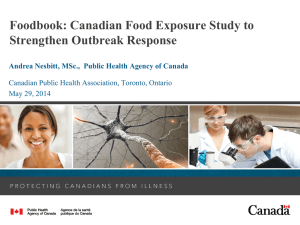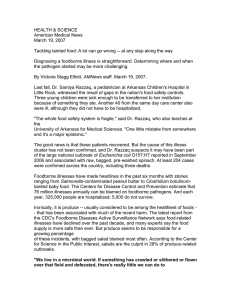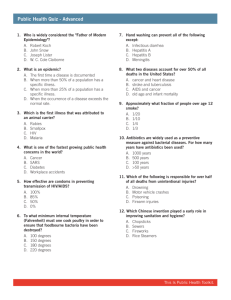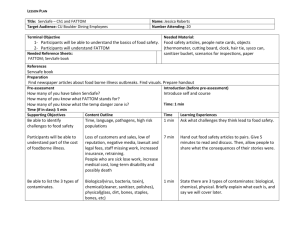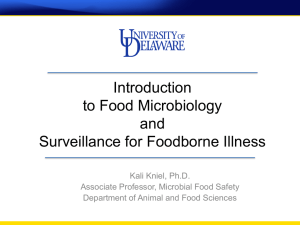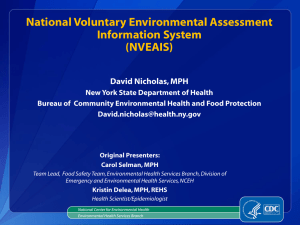Producing Food is Risky Business
advertisement
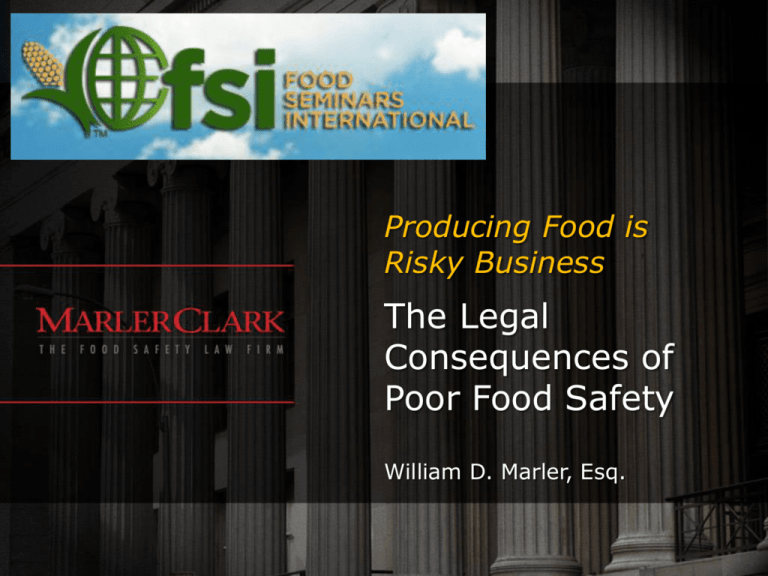
Producing Food is Risky Business The Legal Consequences of Poor Food Safety William D. Marler, Esq. Food Production is a Risky Business • Competitive Markets • Wall Street, Stockholder and Management Pressures for Increasing Profits • Lack of Clear Rewards for Marketing and Practicing Food Safety • Risk of Litigation To Put Things in Perspective • • • • • • According to the CDC, microbial pathogens in food cause an estimated 48 million case of human illness annually in the United States 125,000 hospitalized 3,000 deaths Foodborne Illness in United States cost $152,000,000,000 yearly – PEW That cost includes doctor and hospital visits, medications, lost wages and productivity, functional disabilities, and death It does not include recall cost, price of litigation or loss of reputation A Legal Lesson – Strict Product Liability • Strict Liability – Three Questions 1. Are you a manufacturer? 2. Was the product unsafe? 3. Did the product cause injury? Who is a Manufacturer? • “A manufacturer is defined as a product seller who designs, produces, makes, fabricates, constructs, or remanufacturers the relevant product or component part of a product before its sale to a user or consumer.” Was the Product Unsafe? • Proving a Product is Unsafe = Defective 1. 2. 3. 4. Was the product unsafe beyond that which is expected by a reasonable consumer? Did the product deviate in some material way from specifications? Was the product not reasonably safe as it was designed? Was the product not reasonably safe due to a failure to warn or instruct? Did the Product Cause Injury? • You tell me: It’s the Product not the Conduct • The focus is on the product; not the conduct • It is called Strict Liability for a Reason: 1. 2. 3. The only defense is prevention It does not matter if you took all reasonable precautions If you manufacturer a product that makes someone sick you are going to pay Why Strict Liability? • Puts pressure on those (manufacturers) that most likely could correct the problem in the first place • Puts the cost of settlements and verdicts directly onto those (manufacturers) that profit from the product – cost shifting • Creates incentive not to let it happen again Planning against Litigation – What’s Important? • Identify Hazards 1. 2. HACCP Do you have qualified and committed people? • What is your Food Safety Culture? • Are Vendors and Suppliers Involved? 1. 2. 3. 4. Do they have a plan? Do they have a culture? Ever visit them? Contractual Indemnity? The Chaff – Cases We Turn Away Every Day • • Since 1993 Marler Clark has represented thousands of • legitimate food illness victims in over 47 States. Settlements and Verdicts – total over $600,000,000. Only a fraction of the victims who contact our office end up being represented. Who do we turn away? Why? Incubation Period • The time between ingestion of a foodborne pathogen and the onset of symptoms, are only ranges – and wide ones at that – they can still be used to identify a suspect food-poisoning claim. Incubation Periods of Common Foodborne Pathogens PATHOGEN INCUBATION PERIOD Staphylococcus aureus 1 to 8 hours, typically 2 to 4 hours. Campylobacter 2 to 7 days, typically 3 to 5 days. E. coli O157:H7 1 to 10 days, typically 2 to 5 days. Salmonella 6 to 72 hours, typically 18-36 hours. Shigella 12 hours to 7 days, typically 1-3 days. Hepatitis A 15 to 50 days, typically 25-30 days. Listeria 3 to 70 days, typically 21 days Norovirus 24 to 72 hours, typically 36 hours. Within Hours of Eating • After getting out of church yesterday morning, I stopped at a restaurant to grab a sandwich…. Within two hours of eating that sandwich I became very ill. “Gross-Out” Claims “I opened a box of Buffalo wings and saw an unusually shaped piece of chicken and I picked it up. When I saw that the ‘piece’ had a beak, I got sick to my stomach. My lunch and diet coke came up and I managed to christen my carpet, bedding and clothing. I want them to at least pay for cleaning my carpet etc.” In Between the Quickly Dismissed and the Clearly Compelling • Health department investigation of an outbreak or incident • Prior health department inspections • Medical records • Lab results Health Department Investigation of an Outbreak • All states have agencies tasked with monitoring bacterial and viral illnesses associated with food consumption • The scope of the investigation varies from case to case • It is very difficult to dispute a health departmentconfirmed outbreak or even an isolated case. • Health departments do not point the finger prematurely. Most epidemiologists will not confirm an outbreak without 95% confidence in a particular conclusion. The Long Pathway of a Foodborne Illness Investigation The Pathway Continued If there are more ill persons than expected, an OUTBREAK might be underway Not over Quite Yet Can the Plaintiff Make a Case Without Health Department Support? • In cases in which the health department cannot rule out a source but also cannot identify it with 95% certainty, it is possible for a plaintiff to make a claim for damages even without a health department’s confirmation of an outbreak. • In these cases, reliable expert opinion or examination of the health department investigators themselves can establish the source of a plaintiff’s illness with sufficient certainty to meet the legal burden of proof. Proving a Case Using Prior Health Inspections/Violations • Document the food service establishment’s sordid past. • Documents can be acquired through the discovery process or through the Freedom of Information Act. • A list of improper techniques and code violations can serve as a tool for limiting a defendant’s trial options. Identifying the Improper Procedure That Led to the Contamination of the Food • It is rare that contaminated leftovers can be located by the time investigative agencies or lawyers are on the scene. Improper Cooking Procedures • A young girl suffered HUS after eating a hamburger from a midsized southern California fast-food chain. • Her illness was not culture-confirmed. • No food on site tested positive for E. coli O157:H7. • Review of health inspections revealed flaws in cooking methods. Hamburger buns are toasted on the grill immediately adjacent to the cooking patties, and it is conceivable that, early in the cooking process, prior to pasteurization, meat juices and blood containing active pathogens might possibly splash onto a nearby bun. Improper Refrigeration • A Chinese buffet-restaurant in Ohio was the suspected source of an E. coli O157:H7 outbreak. • No contaminated leftover food was found. • A number of ill patrons were children. Jell-O was suspected as the vehicle of transmission. • Health Department report noted “raw meat stored above the Jell-O in the refrigerator.” The likely source of E. coli O157:H7 in the Jell-O was from raw meat juices dripping on the Jell-O while it was solidifying in the refrigerator. Improper Storage and Cooking Procedures • Banquet-goers in southeastern Washington tested positive for Salmonella. • Leftover food items had been discarded or tested negative. • Restaurant had “pooled” dozens, if not hundreds, of raw eggs in a single bucket for storage overnight, then used them as a “wash” on a specialty dessert that was not cooked thoroughly. Patterns of Poor Food-Handling Practices • In a situation where defending the case from a liability standpoint is a less-than-certain undertaking, defense counsel may be wary of admission of evidence that will make the defendant look bad in the eyes of the jury. Improper Sanitation • In 2000, large Shigella outbreak on the West Coast – producer and distributor of high-end fresh food items. – A major purchaser of the producer had conducted its own inspection and refused to purchase any more of the firm’s products. • In 2002, Seattle-area restaurant had outbreak of food poisoning. Unable to pinpoint pathogen, but prior inspection reports revealed a consistent pattern of poor food-handling practices. Proving a Case Using Medical Records • Evidence of a possible foodborne illness source can sometimes be found in the person’s medicaltreatment records, such as an emergency room notation of a suspected food or drink item, or a lab test result. What Type of Medical Evidence Can Help Make a Case? • Lab tests aren’t always available • Each foodborne pathogen carries an expected incubation period • Most common bacterial and viral pathogens found in food share similar symptoms Proving a Case Using Lab Tests • Many states require reporting of tests for a number of pathogens, including; – E. coli O157:H7 – Salmonella – Shigella – Listeria – Hepatitis A – Campylobacter • The process of obtaining the DNA fingerprint is called Pulse Field Gel Electrophoresis (PFGE). Proving a Case Using PFGE • The PFGE pattern of bacteria isolated from contaminated food can be compared and matched to the PFGE pattern of the strain isolated from the stool of infected persons. • When paired, PFGE and epidemiological evidence are extremely potent in supporting causation. Proving a Case with PulseNet • PulsetNet is an earlywarning system for outbreaks of foodborne disease. • Using this system scientists at labs throughout the country can rapidly compare the PFGE patterns of bacteria from ill persons to help determine where the outbreak occurred. The Impact of the Absence of a Positive Test • A negative test result or the lack of any lab test at all, can sometimes be explained by other factors. – Antibiotics – Untimely Testing – No test given – Looking at the circumstances as a whole – Testing the food Discovery: Worthless Excuse Number 1 • “I never read that memo” • If a document contains damning information, the jury will assume you read it, understood it, and ignored it Odwalla Odwalla Jack in the Box Jack in the Box Jack in the Box Conclusion • Decision makers in the food industry must be prepared to quickly and accurately assess potential foodborne illness claims. • They must have an understanding of the epidemiological, microbiological, and environmental health issues at play. • Rash action to disregard or deny a claim could be damaging to the company and to the public. • References: • www.slideshare.net

